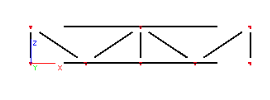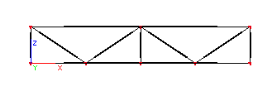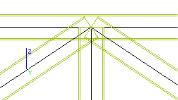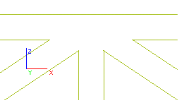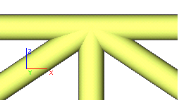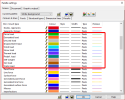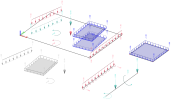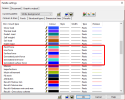Overview of view parameters
Available view parameters
Note: In addition to these general view parameters, there are a few specialised tabs with view parameters for a particular advanced module, e.g. Steel code check, etc. These tabs are not shown until such a module is initialised.
Note : The following list contains the available view parameters. It should be noted that not all of them are always offered in the Setup dialogue. The Setup dialogue offers only those parameters for which the appropriate entity type has been already defined. E.g. until you define at least one support in your model, view parameters for supports are not shown in the dialogue.
Tab Structure
Tab Structure > Group Service
Display on opening the service
If ON, entities appropriate for the service are automatically displayed as soon as the service is opened (in the tree menu). If OFF, no change of display takes place when a service is opened.
Tab Structure > Group Structure
Style + colour
It controls the style and colour of members of the model (beams, plates, shells, etc.)
normal: settings made in Setup > Colour/Lines dialogue are used,
by layers: each member is displayed in the colour of the appropriate layer, all members assigned to the same layer are of the same colour,
by material: each member is displayed in the colour of the appropriate material, all members made of the same material are of the same colour,
by cross-section: each member is displayed in the colour of the appropriate cross-section, all members of the same cross-section are of the same colour,
according to structuraltype: each member is displayed in the colour corresponding to its structural type.
Note : If e.g. two materials, two layers, two cross-sections have assigned the same colour, than the same colour is used for members of different controlling property.
Draw member system line
The system line (midline) is drawn if this option is ON.
Note: If this option is OFF and also Member surface is OFF, then the whole structure disappears from your view.
Member system line style
It controls the style of the member's system line (midline)
Definitions: System line is a line connecting the nodes of a member. This line is what you define when you input a new member. Fine elements are also generated on this system line. Reference line coincides with the system line if no eccentricity of a member is defined. If eccentricity is defined, the reference line is the centroidal axis of the member. Even if eccentricity is defined, the finite elements are generated on the system line (and the defined eccentricity is used in the relevant formulas of the finite elements). Bar is a highlighted system line. However, the bar is not drawn from the node to the node. It just indicates the member and leaves some space around the node for further information to be displayed.
system line: the system line of members is drawn.
system line + reference line: system line (solid) and possibly reference line (dashed) is displayed
bar: highlighted "system line" is drawn
system line + bar: the system line is displayed and it is highlighted with the bar
Model type
You can define different geometry parameters for the "calculation model" of your structure and for the " structural model" of your structure. The calculation model is used for the numerical analysis, the structural model can be used for drawings, detailing, attractive presentations of your project, etc. For example, you can define different eccentricities in the two models, you can define cut-offs at ends of 1D members in the structural model, etc. This parameter tells the program which model you want to see on the screen.
analysismodel: the parameters relating to the calculation model are used to display the structure
structural model: the parameters relating to the structural model are used to display the structure
Example: When you open the property table of a member, the calculation-model-parameters are in the top part of the table. The structural -model-parameters are grouped lower in the table under heading structuralmodel.
Member surface
It defines whether the surface of members should be displayed.
Rendering
specifies the style the surface of members is displayed
wired: only the wired scheme of the surface is displayed
hidden lines: the real surface is calculated and those surface lines that are hidden from the view are not drawn
rendered with edges: the real rendered view with outlined edges is displayed
rendered: the real rendered view is displayed
transparent: the surface is filled but it is transparent (this rendering style may be e.g. useful when you want to present designed steel frame connections - the structure may be transparent, the connection may be fully rendered)
Example: The picture shows the combination of transparent rendering style for 1D member and full-rendering for connection.
Draw cross-section
This option tells if the cross-section of a 1D member should be displayed.
Cross-section style
If the previous option is ON, this item defines the style of the displayed cross-section.
section: one section is drawn about in the middle of each 1D member. The section is 3D oriented, i.e. it is displayed AS IS in the structure and in some views may not be clearly recognisable.
in screen plane: one section is drawn about in the middle of each 1D member. The section is transformed into the screen plane so that it is clearly recognisable in all view of the structure.
longitudinal XZ: a short part of XZ projection of the 1D member surface is drawn. In other views than side view, the section may be hardly recognisable.
longitudinal XY: a short part of XZ projection of the 1D member surface is drawn. In other views than plan view, the section may be hardly recognisable.
Tab Structure > Group Structural node
Display
The FE nodes of the structure can be displayed or hidden. Especially in very large models, it may be convenient to hide the nodes when a picture of the whole model is to be drawn.
Mark style
Specifies the style )shape) of the node mark.
Mark size
Specifies the size of the node mark.
Tab Structure > Group Member parameters
Buckling lengths
Buckling lengths (in all directions) for individual 1D members are displayed.
Member non-linearities
If a non-linearity is assigned to a member, a symbol is displayed indicating the type of the assigned non-linearity.
FEM Type
Various FEM types can be assigned to individual members (tension only, normal 1D member) and a description indicating the selected type is displayed if this option is ON.
Tab Structure > Group Mesh
Draw mesh
The generated mesh is displayed (the mesh can be displayed only if it has been already generated).
Draw refinement
The FE mesh can be refined in manually defined area and the defined refinements are displayed if this option is ON
Note : The finite element mesh can ONLY be displayed if at one calculation has been already performed and its results are still available.
Tab Structure > Group Local axes
Nodes
Axes of local coordinate systems of individual nodes are displayed.
Members 1D
Axes of local coordinate systems of individual 1D members are displayed.
Members 2D
Axes of local coordinate systems of individual plate and shell members are displayed.
Tab Structure > Group Sections
Members 1D
Sections (i.e. sections for the evaluation of results) on 1D members are displayed.
Members 2D
Sections (i.e. sections for the evaluation of results) through plate/shell members are displayed.
Tab Structure > Group Calculation info
Display singularity
If a calculation fails, the problematic place is shown.
Tab Labels
Tab Labels > Group Beam labels
Display label
It controls the group as a whole - if ON, the selected labels are displayed, if OFF, no labels of the group are shown.
Name, Cross-section name, Cross-section type, Length, Layer, Type and priority
Individual labels correspond to individual items in the property table of a member.
Tab Labels > Group Node labels
The meaning is more or less self-explanatory.
Tab Labels > Group Slab labels
The meaning of most of the view flags is more or less self-explanatory.
Edges
Each edge of a slab has a unique number (unique within the single slab) and these edge numbers are displayed if this option is ON.
Tab Labels > Group Mesh
Display label
see above
Nodes
FE-node numbers
Elements 1D
Numbers of 1D finite elements.
Elements 2D
Numbers of 2D finite elements.
Note: The finite element mesh can ONLY be displayed if the calculation has been already performed and its results are still available or if the mesh has been generated by means of function Calculation > Generate mesh.
Tab Labels > Group Buckling lengths
Display label, Name
The meaning is more or less self-explanatory
Label
Description of the buckling length including the dimension.
Tab Labels > Group Sections
Display label, Name
The meaning is more or less self-explanatory.
Tab Labels > Group Non-linearities
Display label
The label of the defined type of non-linearity.
Tab Model
Tab Model > Group Service
Display on opening the service
If ON, entities appropriate for the service are automatically displayed as soon as the service is opened (in the tree menu). If OFF, no change of display takes place when a service is opened.
Tab Model > Group Supports
The meaning of most of the view flags is more or less self-explanatory.
Tab Model > Group Other model data
The meaning of the view flags is more or less self-explanatory.
Tab Model > Group Support labels
Displays the label of supports.
Tab Model > Group Labels of other model data
Displays the label of other model data such as hinges, cross-links, etc. This view parameter displays or hides the label for all the types of other model data at the same time. It is not possible to attach the label to e.g. one type of other model data only.
Tab Loads
Tab Loads > Group Service
Display on opening the service
If ON, entities appropriate for the service are automatically displayed as soon as the service is opened (in the tree menu). If OFF, no change of display takes place when a service is opened.
Tab Loads > Group Display loads
Display
If OFF, no load is displayed at all. This item controls the whole tab.
Style
If the style Colour by action type is selected, the loads are displayed depending on the type of action (forces, wind, snow, imposed displacement, temperature, etc...). Line colour and style can be configured in the palette for each type of action.
If the style Colour by load type is selected, the loads displayed depending on the type of force (point force, line force, surface force). Line colour and style can be configured in the palette for each type of load. Please note, that generated loads have their own, separate line styles.
Please note, that the style of some types of loads/actions do not depend on the selected display style. Those exceptions are:
- Unused loads
- Displacement loads
- Thermal loads
Load case
You can select here the load case to be displayed.
Plane load generator
Displays the loading polygon of the plane load generator.
Absences
Displays the absences.
Absence
You can select here the absence group to be displayed.
Tab Loads > Groups for individual type of load
The meaning of the view flags is more or less self-explanatory.
Tab Loads > Groups Labels of loads
Display label
This item controls the display of load labels.
Name
If ON, the name of the load is attached to every loading impulse (force, moment, temperature load, etc.)
Value
Shows the "input" value of the load.
See the note below.
Total value
Shows the "real" value of the load.
See the note below.
Note: Items Value and Total value are significant for loads that are not defined directly by its force or moment impulse, but that were defined by means of a wind generator, load generator, or as a predefined load. For such loads, SCIA Engineer can display two different types of data. First, the input value (e.g. width load) can be shown, i.e. the value. Second, the calculated load per meter of length can be displayed (i.e. the total value).
Tab Loads > Groups Masses
Displays the masses.
Tab Loads > Groups Labels of loads
Display label
This item controls the display of mass labels.
Name
If ON, the name of the mass is attached to the mass symbol.
Value
Shows the size of the mass.
Tab View
Tab View > Groups Display tools
Disable tooltips
If ON, no tooltips in the graphical window are shown. I.e. no information concerning the entity under cursor is displayed. This option may reduce the response time in large projects. It also reduces the size of images in the Picture gallery.
Before this option takes effect, the screen must be regenerated.
Disable layers
If ON, no information on layers is stored in the data for the graphical window. This option may reduce the response time in large projects. It also reduces the size of images in the Picture gallery.
However, if this option is ON, it is not possible to e.g. make export of the drawing into DXF file including layers – only one "universal" layer is exported.
Before this option takes effect, the screen must be regenerated.
On the other hand, this option does not prevent you from using e.g. activity by layers. This feature is fully working regardless of this parameter.
View vector X, Y, Z
Enables the user to numerically adjust the view direction.
Clipping box
Switches the Clipping box ON/OFF.
Tab Miscellaneous
Tab Miscellaneous > Group Results diagram
Results
Displays the result diagrams on members.
Tab Miscellaneous > Group Construction stages
Display
Displays data relating to construction stages.
It controls the group as a whole - if ON, the selected labels are displayed, if OFF, no labels of the group are shown.
Already installed
Already installed members are displayed.
Currently installed
Currently installed members are displayed.
Not yet available
Members that are not yet available are displayed.
Already removed
Members that have been already removed are displayed.
Tab Miscellaneous > Group Construction stages data labels
Label local beam history
Attaches labels to the local 1D member history.
Tab Miscellaneous > Group Connection force
Display
Displays the forces in connections (in joints of several 1D members)
Tab Miscellaneous > Group Connection force labels
Display label
Displays the labels of connection forces.
It controls the group as a whole - if ON, the selected labels are displayed, if OFF, no labels of the group are shown.
Name
The name is attached to connection forces.
Tab Miscellaneous > Group Connection force
Display arrow on maximal deformation
Shows the view flags “Maximal translation” and “Maximal rotation” which are available after the calculation
Display arrow on small mesh elements
Displays the mark (arrow) on elements whose angle is smaller than 5° after the mesh generation, if any
Display arrow on mesh node
Displays the mark on the mesh nodes, if any was defined by the user using command SELMN



